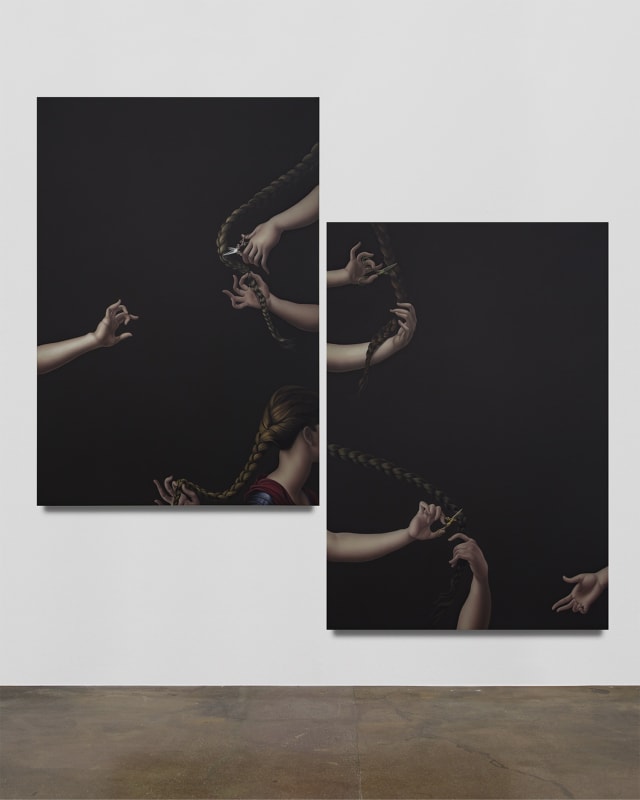Loie Hollowell, Jesse Mockrin, Xiuching Tsay, and Naotaka Hiro, whose work is featured in a Kohn Gallery group exhibition, on the shifting foundations of identity
How does an artist shape and portray their identity? Curator Joshua Friedman explores the question in myselves, a group exhibition at Kohn Gallery in Los Angeles until October 31. The group show features work from 25 contemporary artists, including Amoako Boafo, Heidi Hahn, Bruce Conner, Loie Hollowell, Jesse Mockrin, Xiuching Tsay, and Naotaka Hiro. The work, which is as diverse as the artists Friedman selected, ranges from a portrait of a Black woman against a yellow background by Boafo to an abstract pastel piece by Hollowell filled with round forms that allude to the body before pregnancy. Document selected a group of artists who interpret the body through abstraction—Hollowell, Mockrin, Tsay, and Hiro—to ask how the events that have plagued 2020 have affected the way they perceive and ultimately portray their own identities and bodies.
Ann: How have the events of this past year affected the way you perceive your body?
Jesse Mockrin: The pandemic has changed how I exercise, in that I now do so. Before, I was so busy with work, children, and family that I didn’t make time for physical activity. But after a few weeks of quarantine, I began to feel like I would burst out of my skin if I didn’t do something. I started running and, although I am by no means fast, I am faster and I appreciate the physicality of my body more, perhaps even more so under the constant threat of illness.
In a more metaphysical way, I have been thinking about how much the body is at the mercy of the state. The bodies in my paintings are often vulnerable to anonymous interventions coming from outside the frame. I have young children at home, to whom I am teaching that their bodies are private and that other people’s bodies are private, but the reality is that though these rules are very important, the sense of bodily autonomy I’m fostering is illusory. The incompetence of our government’s response to Covid-19 and the ongoing epidemic of police violence have reiterated just how vulnerable the body is to the rule of the state and the injustice that some bodies are still more vulnerable than others.
Ann: In the diptych ‘Before Battle,’ you show hands about to cut off the braid of an anonymous figure. To what is it alluding?
Jesse: For my painting ‘Before Battle’ in the myselves exhibition, I used source material from four different historical European paintings depicting Hypsicratea, a Queen from Ancient Rome who was described as androgynous and who cut off her braid to assume a male appearance to follow her husband into battle. In my painting, fragments from the four different source paintings are woven together across disjointed panels, becoming a reflection of time repeating cyclically and of the figure fractured into multiple identities. They could be six different people, or the same person at four (or six) different moments in time, or any combination. The wall space activated by the misalignment of the panels allows the viewer to extend the image further in the mind.
Ann: Is ‘After’ the next work in the series? Why is hair being pulled?
Jesse: ‘After’ takes elements from two Baroque paintings of Judith with the head of Holofernes, one by Simon Vouet and one by Peter Paul Rubens. The diptych format unites two different representations of Judith made one year apart, in two different countries, almost exactly 400 hundred years ago, into a new painterly space. I have been interested in how representations of female characters from history are coded in terms of perceived gender characteristics of the time. In my paintings, the signifiers of gender are cropped along with the edges of the figure, creating androgynous fragments that are suspended in space, separated from their original context. Thus images depicting Judith and her maid with the severed head of the general they slayed become two interwoven images of hair being pulled in gestures that could be violent, or erotic, or playful. The face of one bleeds into the sleeve of another, as the integrity and identity of the body become fluid.
Ann: How has this past year impacted your portrayal of the body in your work?
Jesse: As deadlines were pushed back due to the pandemic, I found more time to experiment with the portrayal of the body in my work, in terms of color and scale and its alignment (or misalignment). I have been thinking about representation and visibility and the depiction of skin color in my work. I have been thinking about the violence of the state and the violence of categorization, bodies that remain whole, and bodies that are fragmented. I am working on a new group of paintings that mine historical imagery, examining the ways in which we choose to have our bodies interact with one another, whether that is with tenderness or with violence, and the difficulty in telling the difference without context.
Read the full article here.
